Impact of Organisational Behaviour on Employee Performance at Tesco
VerifiedAdded on 2023/01/12
|15
|4540
|39
AI Summary
This report evaluates the impact of organisational behaviour on the performance and operations of Tesco, a multinational retail store. It examines the influence of culture, politics, power, and motivation on employee performance. The report also explores effective team formation within the organisation.
Contribute Materials
Your contribution can guide someone’s learning journey. Share your
documents today.
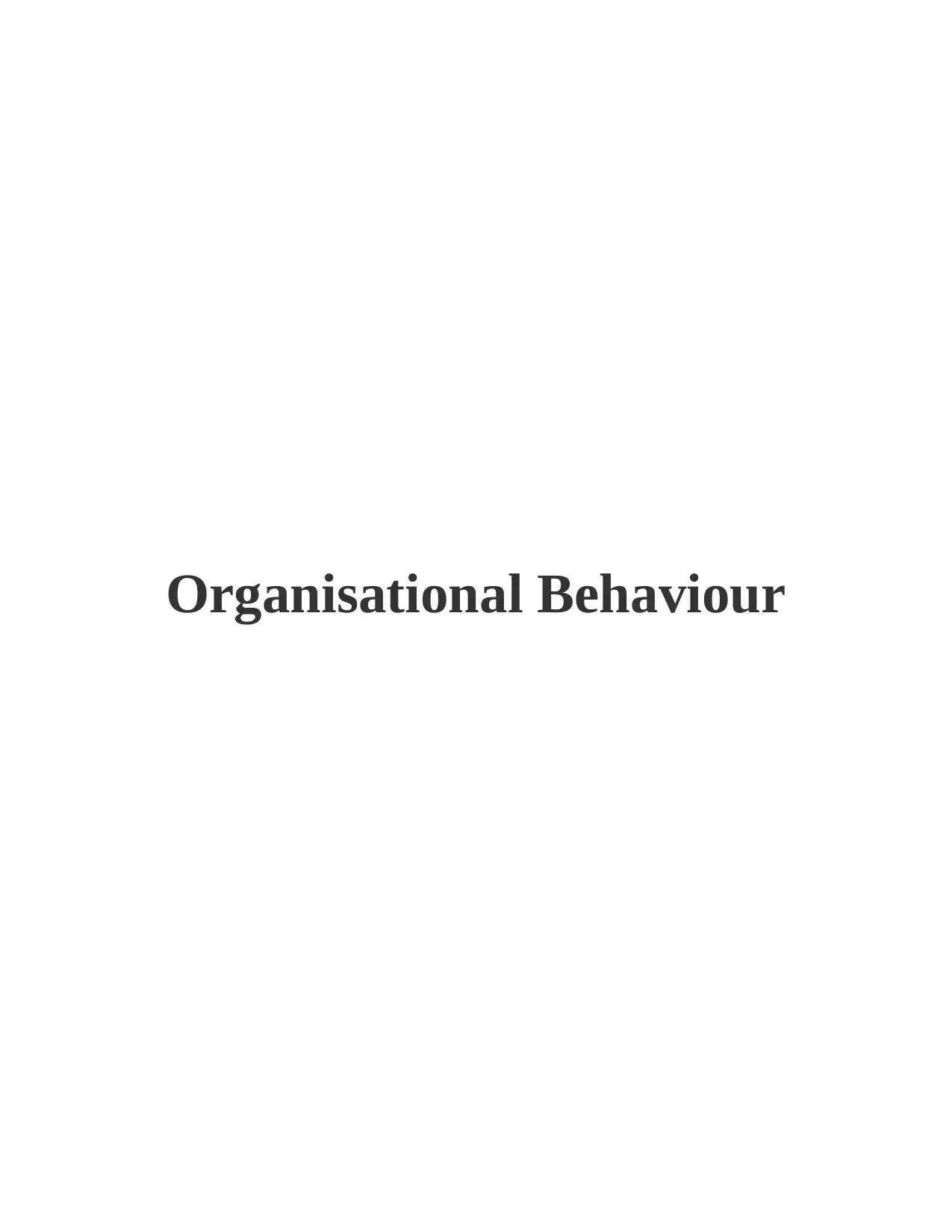
Organisational Behaviour
Secure Best Marks with AI Grader
Need help grading? Try our AI Grader for instant feedback on your assignments.
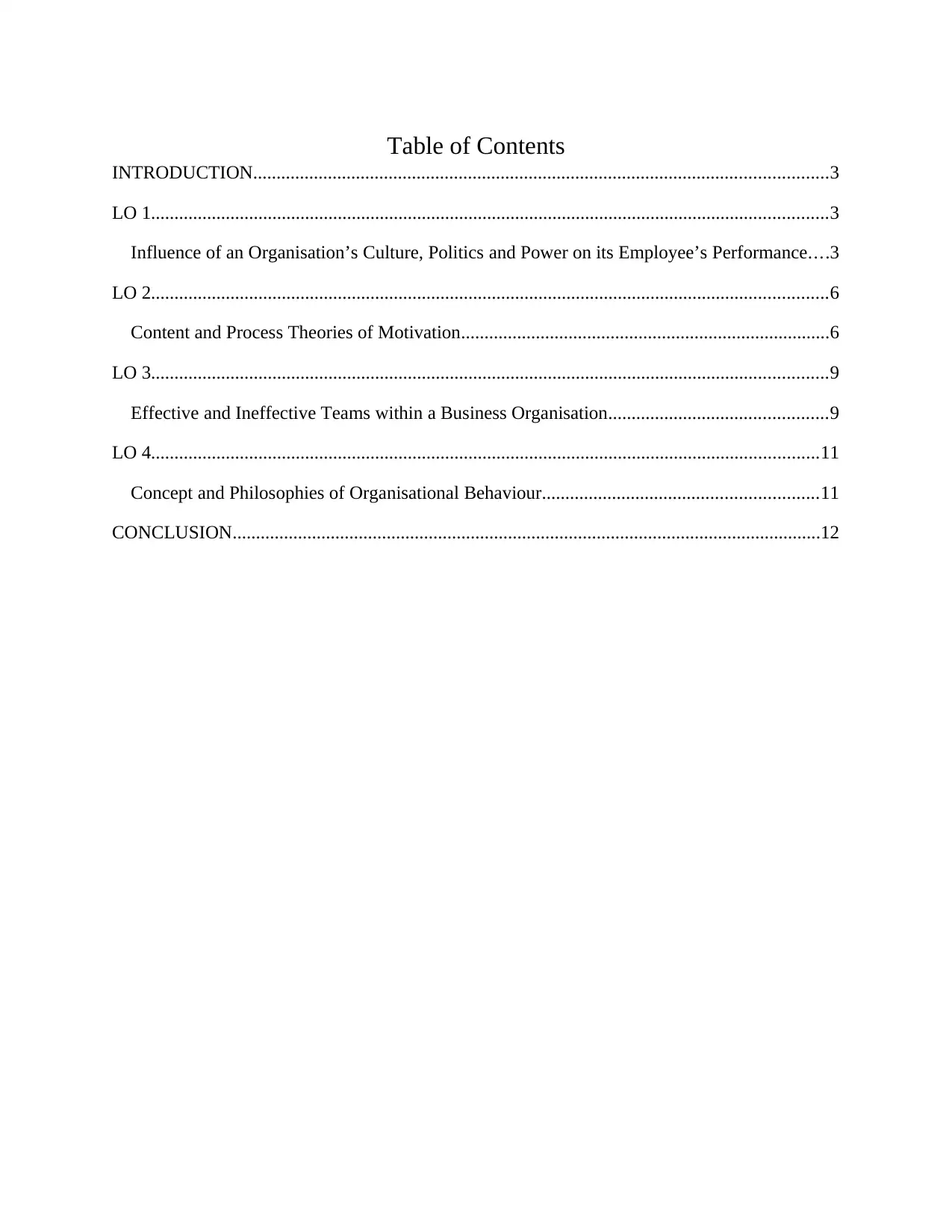
Table of Contents
INTRODUCTION...........................................................................................................................3
LO 1.................................................................................................................................................3
Influence of an Organisation’s Culture, Politics and Power on its Employee’s Performance....3
LO 2.................................................................................................................................................6
Content and Process Theories of Motivation...............................................................................6
LO 3.................................................................................................................................................9
Effective and Ineffective Teams within a Business Organisation...............................................9
LO 4...............................................................................................................................................11
Concept and Philosophies of Organisational Behaviour...........................................................11
CONCLUSION..............................................................................................................................12
INTRODUCTION...........................................................................................................................3
LO 1.................................................................................................................................................3
Influence of an Organisation’s Culture, Politics and Power on its Employee’s Performance....3
LO 2.................................................................................................................................................6
Content and Process Theories of Motivation...............................................................................6
LO 3.................................................................................................................................................9
Effective and Ineffective Teams within a Business Organisation...............................................9
LO 4...............................................................................................................................................11
Concept and Philosophies of Organisational Behaviour...........................................................11
CONCLUSION..............................................................................................................................12
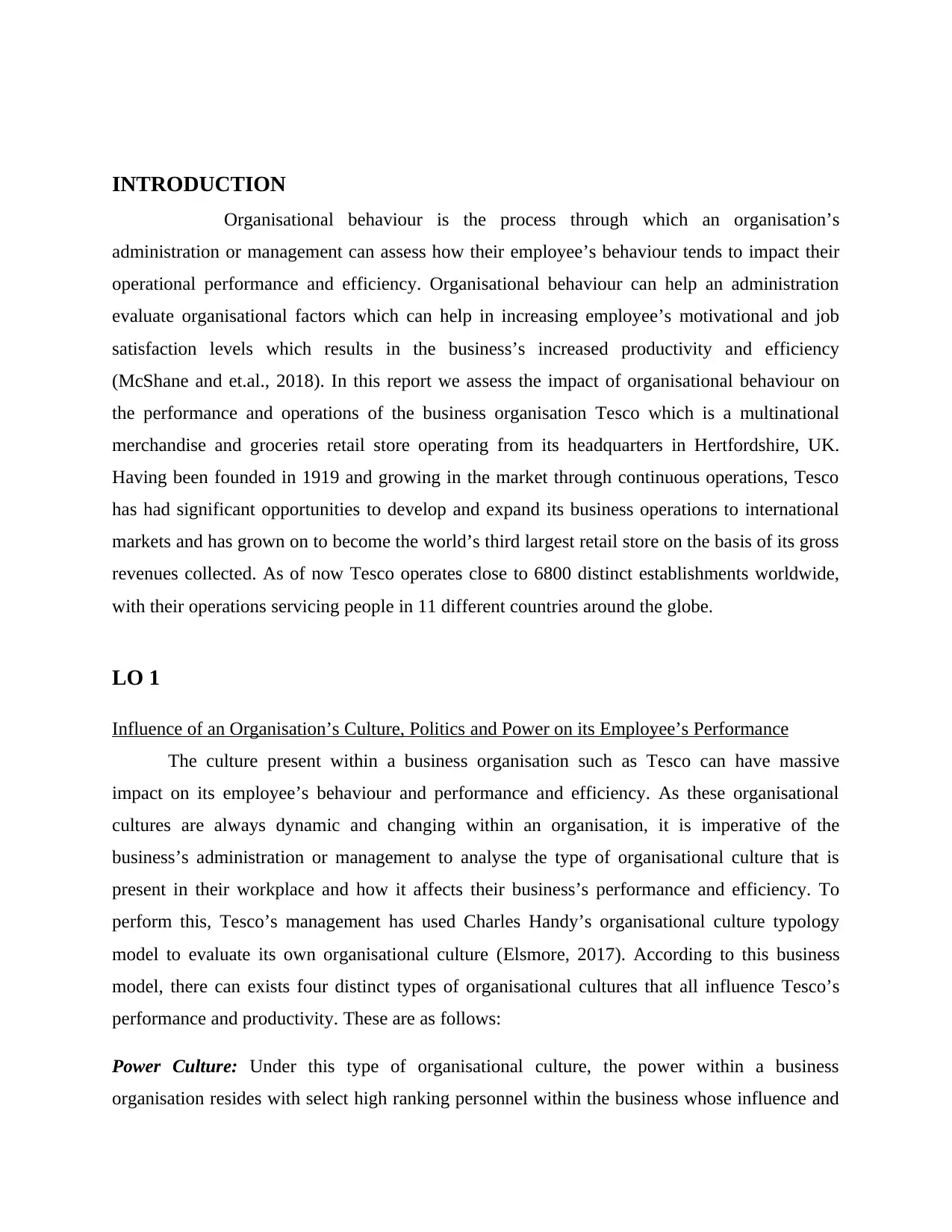
INTRODUCTION
Organisational behaviour is the process through which an organisation’s
administration or management can assess how their employee’s behaviour tends to impact their
operational performance and efficiency. Organisational behaviour can help an administration
evaluate organisational factors which can help in increasing employee’s motivational and job
satisfaction levels which results in the business’s increased productivity and efficiency
(McShane and et.al., 2018). In this report we assess the impact of organisational behaviour on
the performance and operations of the business organisation Tesco which is a multinational
merchandise and groceries retail store operating from its headquarters in Hertfordshire, UK.
Having been founded in 1919 and growing in the market through continuous operations, Tesco
has had significant opportunities to develop and expand its business operations to international
markets and has grown on to become the world’s third largest retail store on the basis of its gross
revenues collected. As of now Tesco operates close to 6800 distinct establishments worldwide,
with their operations servicing people in 11 different countries around the globe.
LO 1
Influence of an Organisation’s Culture, Politics and Power on its Employee’s Performance
The culture present within a business organisation such as Tesco can have massive
impact on its employee’s behaviour and performance and efficiency. As these organisational
cultures are always dynamic and changing within an organisation, it is imperative of the
business’s administration or management to analyse the type of organisational culture that is
present in their workplace and how it affects their business’s performance and efficiency. To
perform this, Tesco’s management has used Charles Handy’s organisational culture typology
model to evaluate its own organisational culture (Elsmore, 2017). According to this business
model, there can exists four distinct types of organisational cultures that all influence Tesco’s
performance and productivity. These are as follows:
Power Culture: Under this type of organisational culture, the power within a business
organisation resides with select high ranking personnel within the business whose influence and
Organisational behaviour is the process through which an organisation’s
administration or management can assess how their employee’s behaviour tends to impact their
operational performance and efficiency. Organisational behaviour can help an administration
evaluate organisational factors which can help in increasing employee’s motivational and job
satisfaction levels which results in the business’s increased productivity and efficiency
(McShane and et.al., 2018). In this report we assess the impact of organisational behaviour on
the performance and operations of the business organisation Tesco which is a multinational
merchandise and groceries retail store operating from its headquarters in Hertfordshire, UK.
Having been founded in 1919 and growing in the market through continuous operations, Tesco
has had significant opportunities to develop and expand its business operations to international
markets and has grown on to become the world’s third largest retail store on the basis of its gross
revenues collected. As of now Tesco operates close to 6800 distinct establishments worldwide,
with their operations servicing people in 11 different countries around the globe.
LO 1
Influence of an Organisation’s Culture, Politics and Power on its Employee’s Performance
The culture present within a business organisation such as Tesco can have massive
impact on its employee’s behaviour and performance and efficiency. As these organisational
cultures are always dynamic and changing within an organisation, it is imperative of the
business’s administration or management to analyse the type of organisational culture that is
present in their workplace and how it affects their business’s performance and efficiency. To
perform this, Tesco’s management has used Charles Handy’s organisational culture typology
model to evaluate its own organisational culture (Elsmore, 2017). According to this business
model, there can exists four distinct types of organisational cultures that all influence Tesco’s
performance and productivity. These are as follows:
Power Culture: Under this type of organisational culture, the power within a business
organisation resides with select high ranking personnel within the business whose influence and
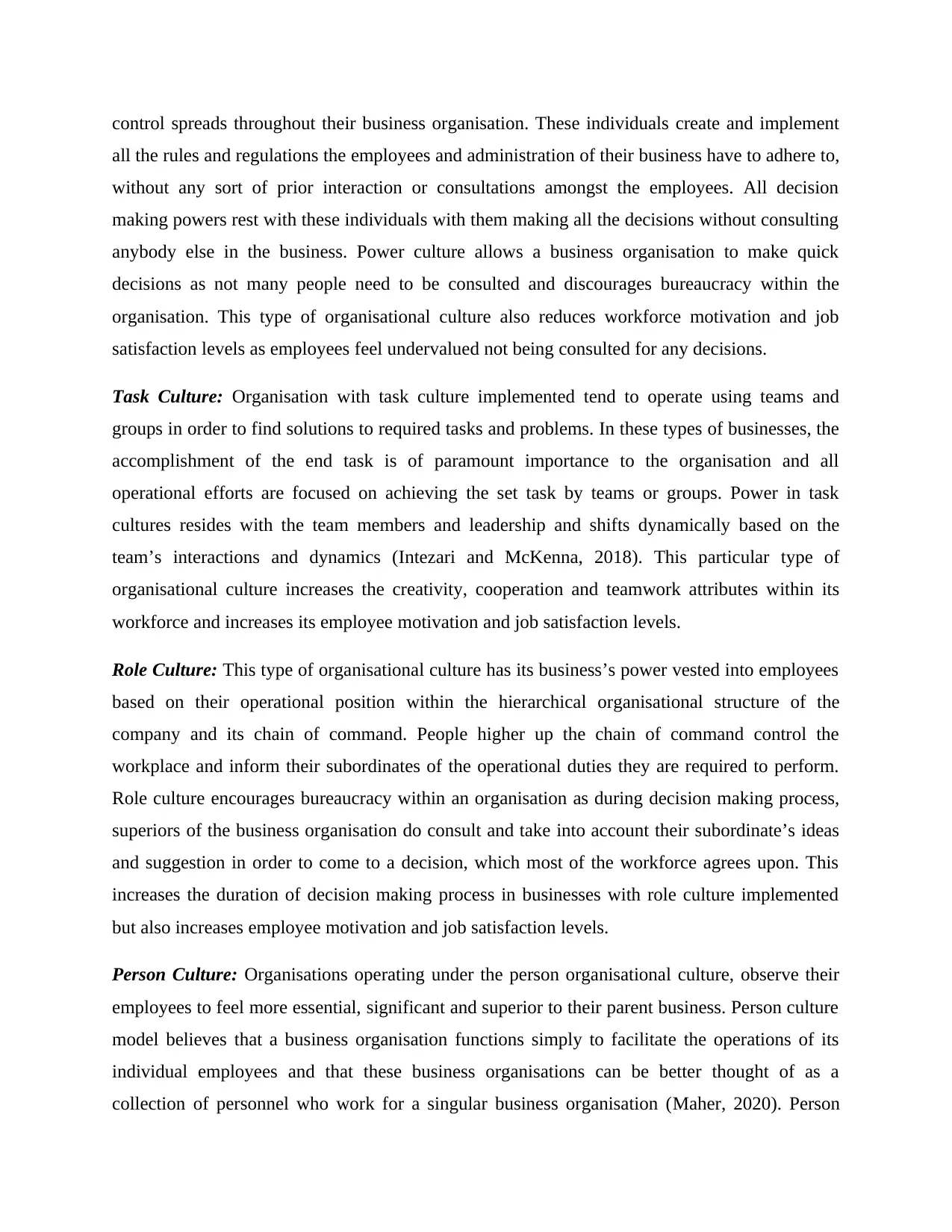
control spreads throughout their business organisation. These individuals create and implement
all the rules and regulations the employees and administration of their business have to adhere to,
without any sort of prior interaction or consultations amongst the employees. All decision
making powers rest with these individuals with them making all the decisions without consulting
anybody else in the business. Power culture allows a business organisation to make quick
decisions as not many people need to be consulted and discourages bureaucracy within the
organisation. This type of organisational culture also reduces workforce motivation and job
satisfaction levels as employees feel undervalued not being consulted for any decisions.
Task Culture: Organisation with task culture implemented tend to operate using teams and
groups in order to find solutions to required tasks and problems. In these types of businesses, the
accomplishment of the end task is of paramount importance to the organisation and all
operational efforts are focused on achieving the set task by teams or groups. Power in task
cultures resides with the team members and leadership and shifts dynamically based on the
team’s interactions and dynamics (Intezari and McKenna, 2018). This particular type of
organisational culture increases the creativity, cooperation and teamwork attributes within its
workforce and increases its employee motivation and job satisfaction levels.
Role Culture: This type of organisational culture has its business’s power vested into employees
based on their operational position within the hierarchical organisational structure of the
company and its chain of command. People higher up the chain of command control the
workplace and inform their subordinates of the operational duties they are required to perform.
Role culture encourages bureaucracy within an organisation as during decision making process,
superiors of the business organisation do consult and take into account their subordinate’s ideas
and suggestion in order to come to a decision, which most of the workforce agrees upon. This
increases the duration of decision making process in businesses with role culture implemented
but also increases employee motivation and job satisfaction levels.
Person Culture: Organisations operating under the person organisational culture, observe their
employees to feel more essential, significant and superior to their parent business. Person culture
model believes that a business organisation functions simply to facilitate the operations of its
individual employees and that these business organisations can be better thought of as a
collection of personnel who work for a singular business organisation (Maher, 2020). Person
all the rules and regulations the employees and administration of their business have to adhere to,
without any sort of prior interaction or consultations amongst the employees. All decision
making powers rest with these individuals with them making all the decisions without consulting
anybody else in the business. Power culture allows a business organisation to make quick
decisions as not many people need to be consulted and discourages bureaucracy within the
organisation. This type of organisational culture also reduces workforce motivation and job
satisfaction levels as employees feel undervalued not being consulted for any decisions.
Task Culture: Organisation with task culture implemented tend to operate using teams and
groups in order to find solutions to required tasks and problems. In these types of businesses, the
accomplishment of the end task is of paramount importance to the organisation and all
operational efforts are focused on achieving the set task by teams or groups. Power in task
cultures resides with the team members and leadership and shifts dynamically based on the
team’s interactions and dynamics (Intezari and McKenna, 2018). This particular type of
organisational culture increases the creativity, cooperation and teamwork attributes within its
workforce and increases its employee motivation and job satisfaction levels.
Role Culture: This type of organisational culture has its business’s power vested into employees
based on their operational position within the hierarchical organisational structure of the
company and its chain of command. People higher up the chain of command control the
workplace and inform their subordinates of the operational duties they are required to perform.
Role culture encourages bureaucracy within an organisation as during decision making process,
superiors of the business organisation do consult and take into account their subordinate’s ideas
and suggestion in order to come to a decision, which most of the workforce agrees upon. This
increases the duration of decision making process in businesses with role culture implemented
but also increases employee motivation and job satisfaction levels.
Person Culture: Organisations operating under the person organisational culture, observe their
employees to feel more essential, significant and superior to their parent business. Person culture
model believes that a business organisation functions simply to facilitate the operations of its
individual employees and that these business organisations can be better thought of as a
collection of personnel who work for a singular business organisation (Maher, 2020). Person
Secure Best Marks with AI Grader
Need help grading? Try our AI Grader for instant feedback on your assignments.
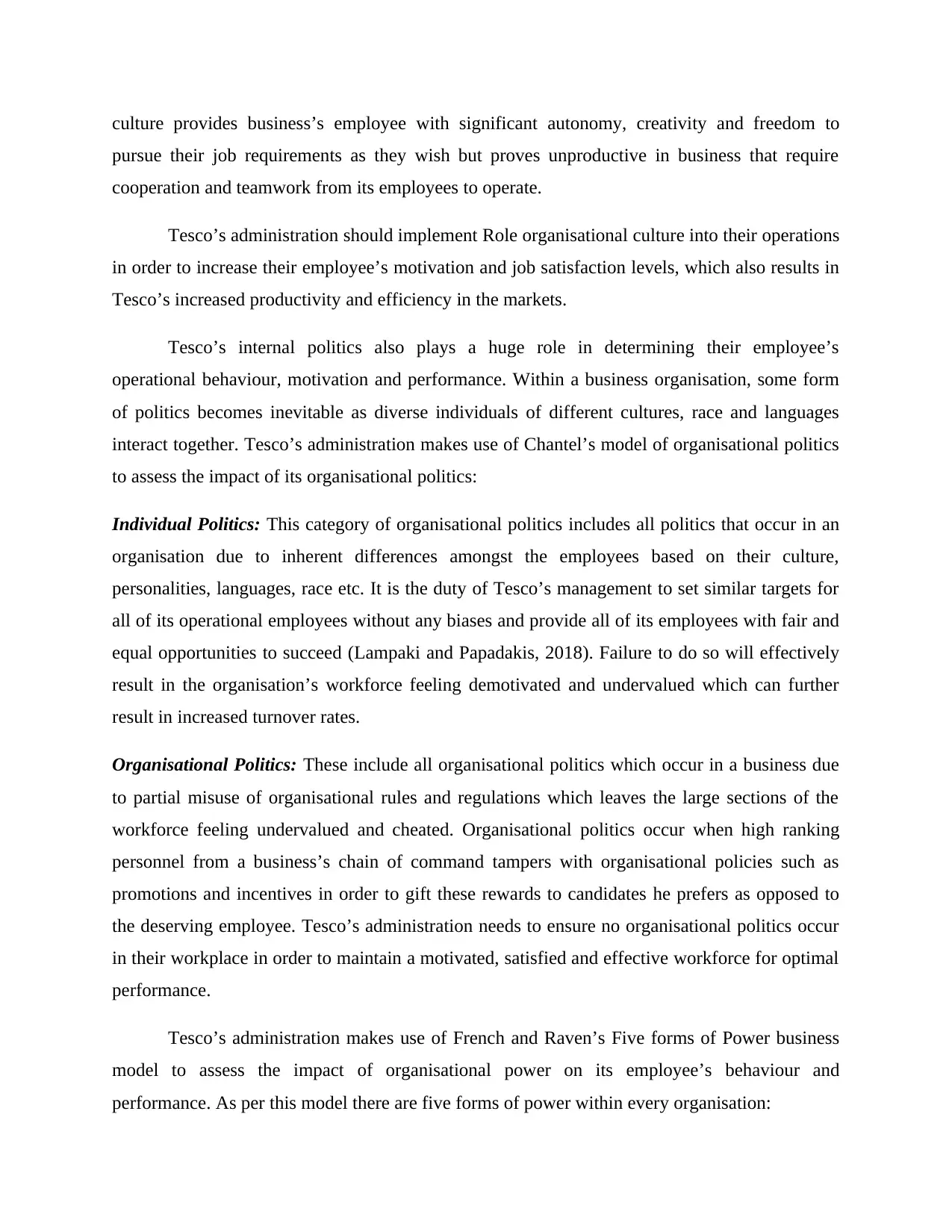
culture provides business’s employee with significant autonomy, creativity and freedom to
pursue their job requirements as they wish but proves unproductive in business that require
cooperation and teamwork from its employees to operate.
Tesco’s administration should implement Role organisational culture into their operations
in order to increase their employee’s motivation and job satisfaction levels, which also results in
Tesco’s increased productivity and efficiency in the markets.
Tesco’s internal politics also plays a huge role in determining their employee’s
operational behaviour, motivation and performance. Within a business organisation, some form
of politics becomes inevitable as diverse individuals of different cultures, race and languages
interact together. Tesco’s administration makes use of Chantel’s model of organisational politics
to assess the impact of its organisational politics:
Individual Politics: This category of organisational politics includes all politics that occur in an
organisation due to inherent differences amongst the employees based on their culture,
personalities, languages, race etc. It is the duty of Tesco’s management to set similar targets for
all of its operational employees without any biases and provide all of its employees with fair and
equal opportunities to succeed (Lampaki and Papadakis, 2018). Failure to do so will effectively
result in the organisation’s workforce feeling demotivated and undervalued which can further
result in increased turnover rates.
Organisational Politics: These include all organisational politics which occur in a business due
to partial misuse of organisational rules and regulations which leaves the large sections of the
workforce feeling undervalued and cheated. Organisational politics occur when high ranking
personnel from a business’s chain of command tampers with organisational policies such as
promotions and incentives in order to gift these rewards to candidates he prefers as opposed to
the deserving employee. Tesco’s administration needs to ensure no organisational politics occur
in their workplace in order to maintain a motivated, satisfied and effective workforce for optimal
performance.
Tesco’s administration makes use of French and Raven’s Five forms of Power business
model to assess the impact of organisational power on its employee’s behaviour and
performance. As per this model there are five forms of power within every organisation:
pursue their job requirements as they wish but proves unproductive in business that require
cooperation and teamwork from its employees to operate.
Tesco’s administration should implement Role organisational culture into their operations
in order to increase their employee’s motivation and job satisfaction levels, which also results in
Tesco’s increased productivity and efficiency in the markets.
Tesco’s internal politics also plays a huge role in determining their employee’s
operational behaviour, motivation and performance. Within a business organisation, some form
of politics becomes inevitable as diverse individuals of different cultures, race and languages
interact together. Tesco’s administration makes use of Chantel’s model of organisational politics
to assess the impact of its organisational politics:
Individual Politics: This category of organisational politics includes all politics that occur in an
organisation due to inherent differences amongst the employees based on their culture,
personalities, languages, race etc. It is the duty of Tesco’s management to set similar targets for
all of its operational employees without any biases and provide all of its employees with fair and
equal opportunities to succeed (Lampaki and Papadakis, 2018). Failure to do so will effectively
result in the organisation’s workforce feeling demotivated and undervalued which can further
result in increased turnover rates.
Organisational Politics: These include all organisational politics which occur in a business due
to partial misuse of organisational rules and regulations which leaves the large sections of the
workforce feeling undervalued and cheated. Organisational politics occur when high ranking
personnel from a business’s chain of command tampers with organisational policies such as
promotions and incentives in order to gift these rewards to candidates he prefers as opposed to
the deserving employee. Tesco’s administration needs to ensure no organisational politics occur
in their workplace in order to maintain a motivated, satisfied and effective workforce for optimal
performance.
Tesco’s administration makes use of French and Raven’s Five forms of Power business
model to assess the impact of organisational power on its employee’s behaviour and
performance. As per this model there are five forms of power within every organisation:
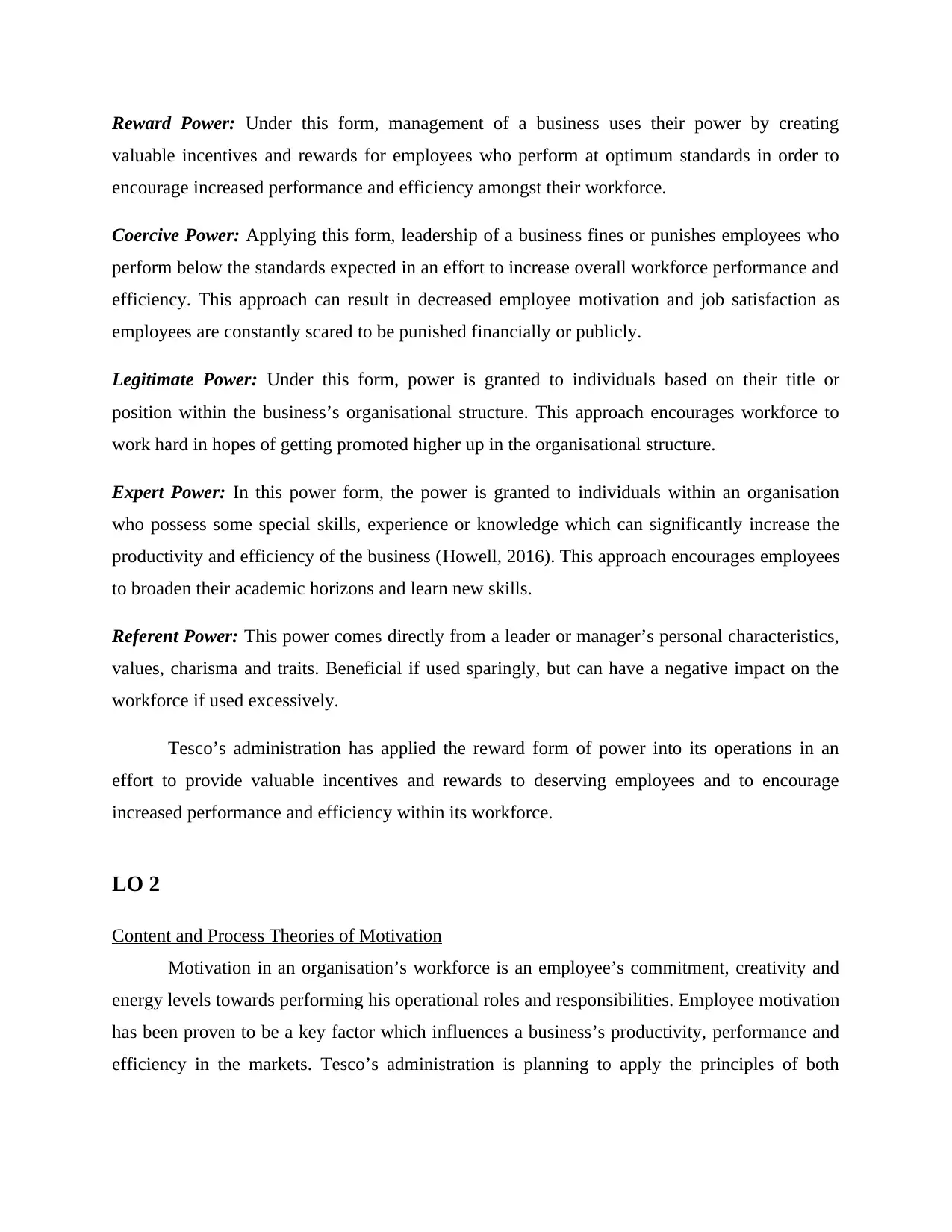
Reward Power: Under this form, management of a business uses their power by creating
valuable incentives and rewards for employees who perform at optimum standards in order to
encourage increased performance and efficiency amongst their workforce.
Coercive Power: Applying this form, leadership of a business fines or punishes employees who
perform below the standards expected in an effort to increase overall workforce performance and
efficiency. This approach can result in decreased employee motivation and job satisfaction as
employees are constantly scared to be punished financially or publicly.
Legitimate Power: Under this form, power is granted to individuals based on their title or
position within the business’s organisational structure. This approach encourages workforce to
work hard in hopes of getting promoted higher up in the organisational structure.
Expert Power: In this power form, the power is granted to individuals within an organisation
who possess some special skills, experience or knowledge which can significantly increase the
productivity and efficiency of the business (Howell, 2016). This approach encourages employees
to broaden their academic horizons and learn new skills.
Referent Power: This power comes directly from a leader or manager’s personal characteristics,
values, charisma and traits. Beneficial if used sparingly, but can have a negative impact on the
workforce if used excessively.
Tesco’s administration has applied the reward form of power into its operations in an
effort to provide valuable incentives and rewards to deserving employees and to encourage
increased performance and efficiency within its workforce.
LO 2
Content and Process Theories of Motivation
Motivation in an organisation’s workforce is an employee’s commitment, creativity and
energy levels towards performing his operational roles and responsibilities. Employee motivation
has been proven to be a key factor which influences a business’s productivity, performance and
efficiency in the markets. Tesco’s administration is planning to apply the principles of both
valuable incentives and rewards for employees who perform at optimum standards in order to
encourage increased performance and efficiency amongst their workforce.
Coercive Power: Applying this form, leadership of a business fines or punishes employees who
perform below the standards expected in an effort to increase overall workforce performance and
efficiency. This approach can result in decreased employee motivation and job satisfaction as
employees are constantly scared to be punished financially or publicly.
Legitimate Power: Under this form, power is granted to individuals based on their title or
position within the business’s organisational structure. This approach encourages workforce to
work hard in hopes of getting promoted higher up in the organisational structure.
Expert Power: In this power form, the power is granted to individuals within an organisation
who possess some special skills, experience or knowledge which can significantly increase the
productivity and efficiency of the business (Howell, 2016). This approach encourages employees
to broaden their academic horizons and learn new skills.
Referent Power: This power comes directly from a leader or manager’s personal characteristics,
values, charisma and traits. Beneficial if used sparingly, but can have a negative impact on the
workforce if used excessively.
Tesco’s administration has applied the reward form of power into its operations in an
effort to provide valuable incentives and rewards to deserving employees and to encourage
increased performance and efficiency within its workforce.
LO 2
Content and Process Theories of Motivation
Motivation in an organisation’s workforce is an employee’s commitment, creativity and
energy levels towards performing his operational roles and responsibilities. Employee motivation
has been proven to be a key factor which influences a business’s productivity, performance and
efficiency in the markets. Tesco’s administration is planning to apply the principles of both
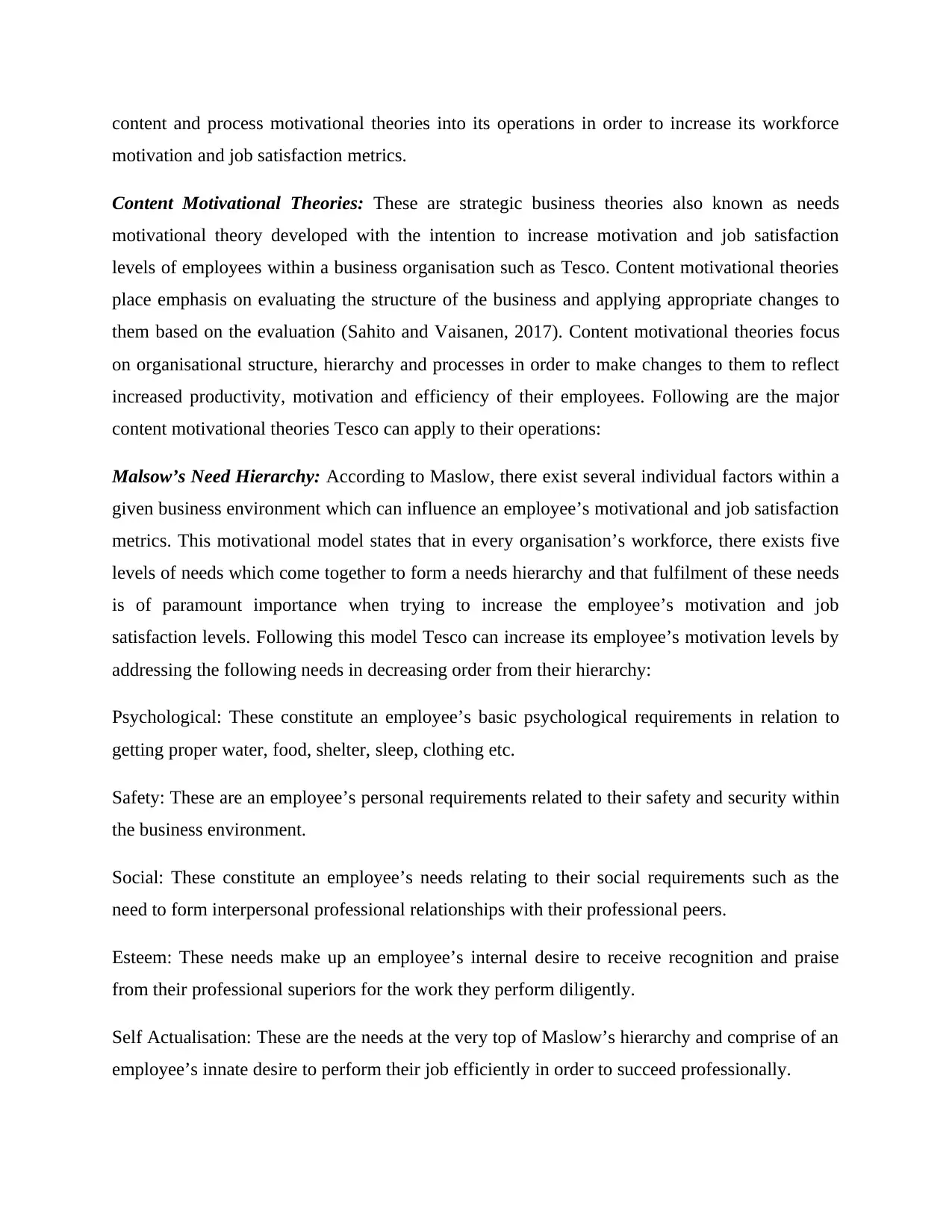
content and process motivational theories into its operations in order to increase its workforce
motivation and job satisfaction metrics.
Content Motivational Theories: These are strategic business theories also known as needs
motivational theory developed with the intention to increase motivation and job satisfaction
levels of employees within a business organisation such as Tesco. Content motivational theories
place emphasis on evaluating the structure of the business and applying appropriate changes to
them based on the evaluation (Sahito and Vaisanen, 2017). Content motivational theories focus
on organisational structure, hierarchy and processes in order to make changes to them to reflect
increased productivity, motivation and efficiency of their employees. Following are the major
content motivational theories Tesco can apply to their operations:
Malsow’s Need Hierarchy: According to Maslow, there exist several individual factors within a
given business environment which can influence an employee’s motivational and job satisfaction
metrics. This motivational model states that in every organisation’s workforce, there exists five
levels of needs which come together to form a needs hierarchy and that fulfilment of these needs
is of paramount importance when trying to increase the employee’s motivation and job
satisfaction levels. Following this model Tesco can increase its employee’s motivation levels by
addressing the following needs in decreasing order from their hierarchy:
Psychological: These constitute an employee’s basic psychological requirements in relation to
getting proper water, food, shelter, sleep, clothing etc.
Safety: These are an employee’s personal requirements related to their safety and security within
the business environment.
Social: These constitute an employee’s needs relating to their social requirements such as the
need to form interpersonal professional relationships with their professional peers.
Esteem: These needs make up an employee’s internal desire to receive recognition and praise
from their professional superiors for the work they perform diligently.
Self Actualisation: These are the needs at the very top of Maslow’s hierarchy and comprise of an
employee’s innate desire to perform their job efficiently in order to succeed professionally.
motivation and job satisfaction metrics.
Content Motivational Theories: These are strategic business theories also known as needs
motivational theory developed with the intention to increase motivation and job satisfaction
levels of employees within a business organisation such as Tesco. Content motivational theories
place emphasis on evaluating the structure of the business and applying appropriate changes to
them based on the evaluation (Sahito and Vaisanen, 2017). Content motivational theories focus
on organisational structure, hierarchy and processes in order to make changes to them to reflect
increased productivity, motivation and efficiency of their employees. Following are the major
content motivational theories Tesco can apply to their operations:
Malsow’s Need Hierarchy: According to Maslow, there exist several individual factors within a
given business environment which can influence an employee’s motivational and job satisfaction
metrics. This motivational model states that in every organisation’s workforce, there exists five
levels of needs which come together to form a needs hierarchy and that fulfilment of these needs
is of paramount importance when trying to increase the employee’s motivation and job
satisfaction levels. Following this model Tesco can increase its employee’s motivation levels by
addressing the following needs in decreasing order from their hierarchy:
Psychological: These constitute an employee’s basic psychological requirements in relation to
getting proper water, food, shelter, sleep, clothing etc.
Safety: These are an employee’s personal requirements related to their safety and security within
the business environment.
Social: These constitute an employee’s needs relating to their social requirements such as the
need to form interpersonal professional relationships with their professional peers.
Esteem: These needs make up an employee’s internal desire to receive recognition and praise
from their professional superiors for the work they perform diligently.
Self Actualisation: These are the needs at the very top of Maslow’s hierarchy and comprise of an
employee’s innate desire to perform their job efficiently in order to succeed professionally.
Paraphrase This Document
Need a fresh take? Get an instant paraphrase of this document with our AI Paraphraser
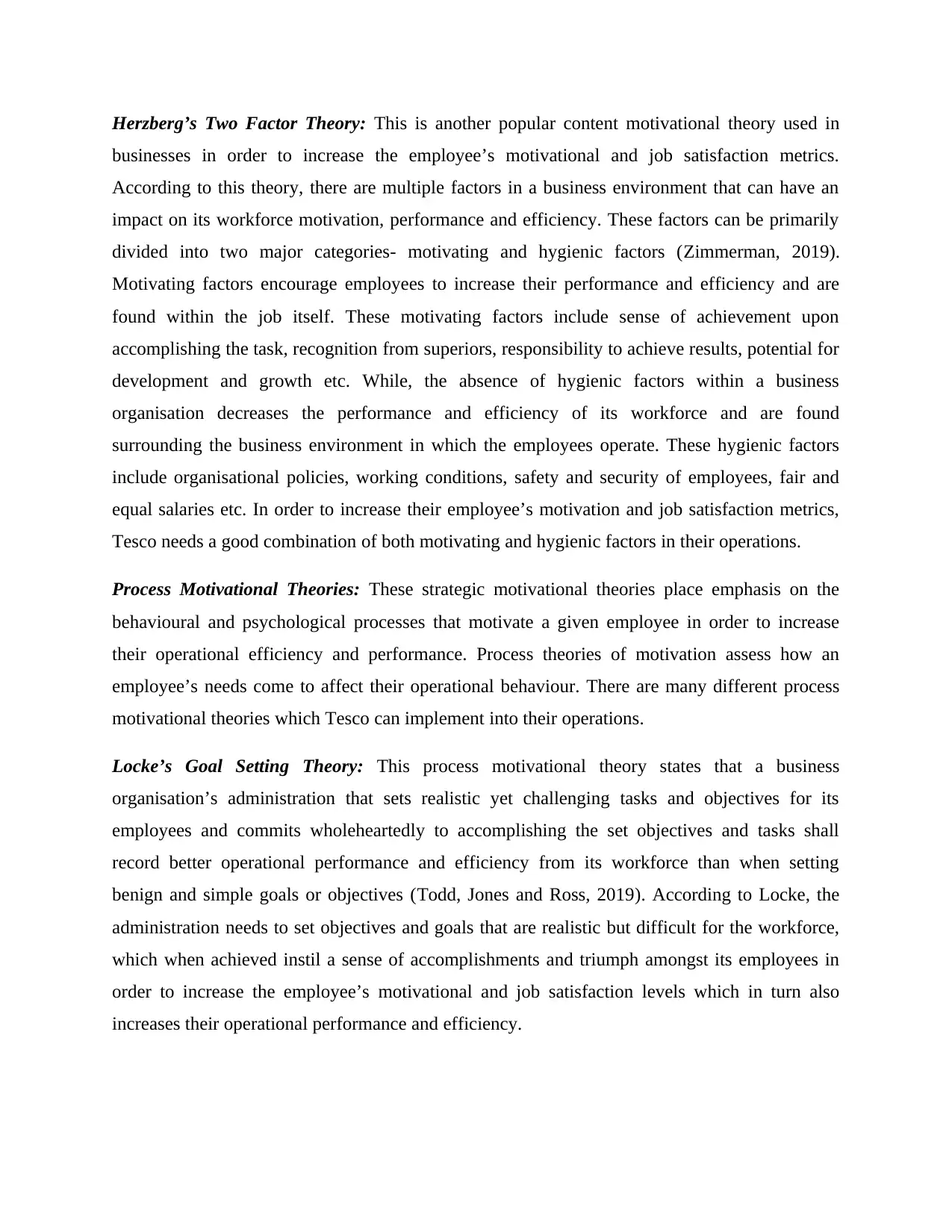
Herzberg’s Two Factor Theory: This is another popular content motivational theory used in
businesses in order to increase the employee’s motivational and job satisfaction metrics.
According to this theory, there are multiple factors in a business environment that can have an
impact on its workforce motivation, performance and efficiency. These factors can be primarily
divided into two major categories- motivating and hygienic factors (Zimmerman, 2019).
Motivating factors encourage employees to increase their performance and efficiency and are
found within the job itself. These motivating factors include sense of achievement upon
accomplishing the task, recognition from superiors, responsibility to achieve results, potential for
development and growth etc. While, the absence of hygienic factors within a business
organisation decreases the performance and efficiency of its workforce and are found
surrounding the business environment in which the employees operate. These hygienic factors
include organisational policies, working conditions, safety and security of employees, fair and
equal salaries etc. In order to increase their employee’s motivation and job satisfaction metrics,
Tesco needs a good combination of both motivating and hygienic factors in their operations.
Process Motivational Theories: These strategic motivational theories place emphasis on the
behavioural and psychological processes that motivate a given employee in order to increase
their operational efficiency and performance. Process theories of motivation assess how an
employee’s needs come to affect their operational behaviour. There are many different process
motivational theories which Tesco can implement into their operations.
Locke’s Goal Setting Theory: This process motivational theory states that a business
organisation’s administration that sets realistic yet challenging tasks and objectives for its
employees and commits wholeheartedly to accomplishing the set objectives and tasks shall
record better operational performance and efficiency from its workforce than when setting
benign and simple goals or objectives (Todd, Jones and Ross, 2019). According to Locke, the
administration needs to set objectives and goals that are realistic but difficult for the workforce,
which when achieved instil a sense of accomplishments and triumph amongst its employees in
order to increase the employee’s motivational and job satisfaction levels which in turn also
increases their operational performance and efficiency.
businesses in order to increase the employee’s motivational and job satisfaction metrics.
According to this theory, there are multiple factors in a business environment that can have an
impact on its workforce motivation, performance and efficiency. These factors can be primarily
divided into two major categories- motivating and hygienic factors (Zimmerman, 2019).
Motivating factors encourage employees to increase their performance and efficiency and are
found within the job itself. These motivating factors include sense of achievement upon
accomplishing the task, recognition from superiors, responsibility to achieve results, potential for
development and growth etc. While, the absence of hygienic factors within a business
organisation decreases the performance and efficiency of its workforce and are found
surrounding the business environment in which the employees operate. These hygienic factors
include organisational policies, working conditions, safety and security of employees, fair and
equal salaries etc. In order to increase their employee’s motivation and job satisfaction metrics,
Tesco needs a good combination of both motivating and hygienic factors in their operations.
Process Motivational Theories: These strategic motivational theories place emphasis on the
behavioural and psychological processes that motivate a given employee in order to increase
their operational efficiency and performance. Process theories of motivation assess how an
employee’s needs come to affect their operational behaviour. There are many different process
motivational theories which Tesco can implement into their operations.
Locke’s Goal Setting Theory: This process motivational theory states that a business
organisation’s administration that sets realistic yet challenging tasks and objectives for its
employees and commits wholeheartedly to accomplishing the set objectives and tasks shall
record better operational performance and efficiency from its workforce than when setting
benign and simple goals or objectives (Todd, Jones and Ross, 2019). According to Locke, the
administration needs to set objectives and goals that are realistic but difficult for the workforce,
which when achieved instil a sense of accomplishments and triumph amongst its employees in
order to increase the employee’s motivational and job satisfaction levels which in turn also
increases their operational performance and efficiency.
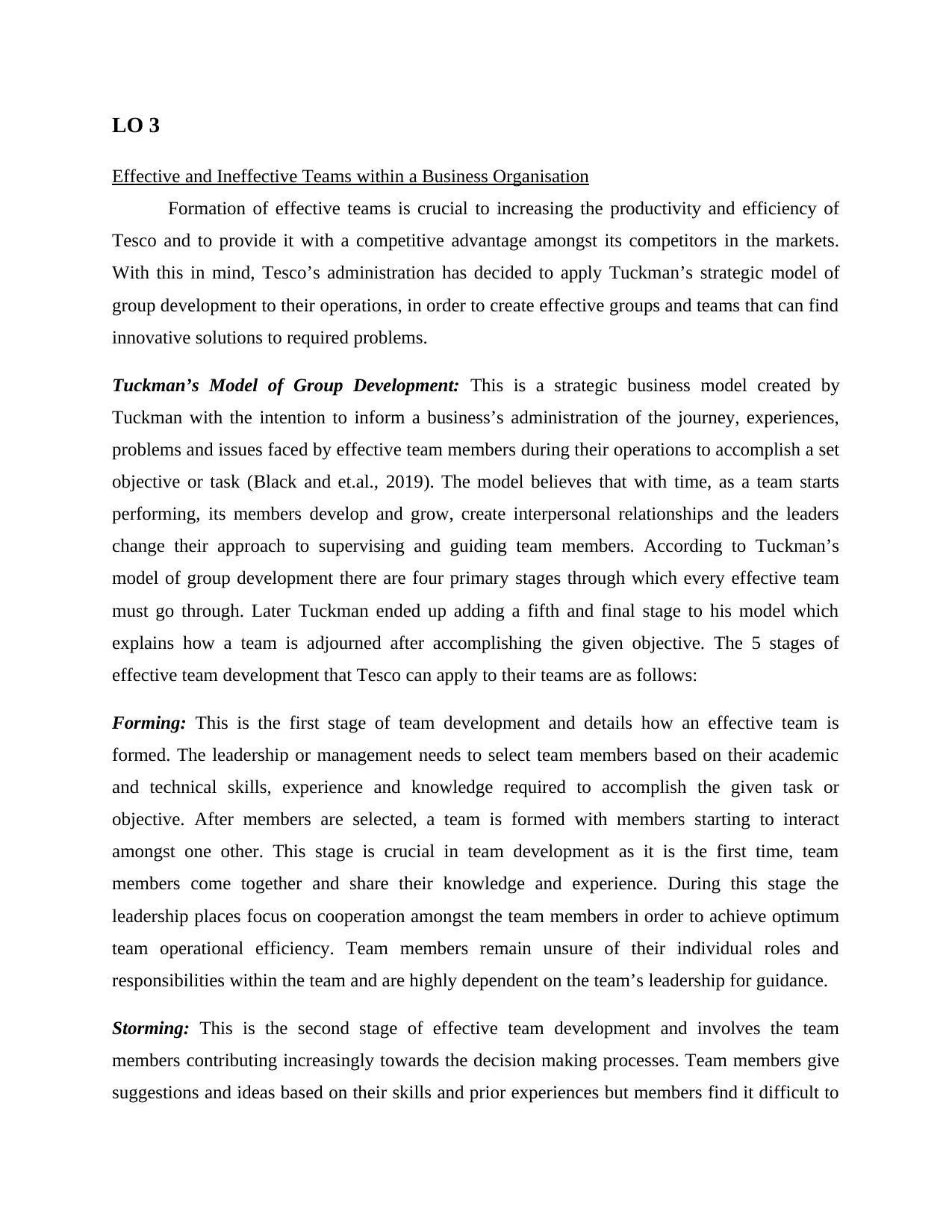
LO 3
Effective and Ineffective Teams within a Business Organisation
Formation of effective teams is crucial to increasing the productivity and efficiency of
Tesco and to provide it with a competitive advantage amongst its competitors in the markets.
With this in mind, Tesco’s administration has decided to apply Tuckman’s strategic model of
group development to their operations, in order to create effective groups and teams that can find
innovative solutions to required problems.
Tuckman’s Model of Group Development: This is a strategic business model created by
Tuckman with the intention to inform a business’s administration of the journey, experiences,
problems and issues faced by effective team members during their operations to accomplish a set
objective or task (Black and et.al., 2019). The model believes that with time, as a team starts
performing, its members develop and grow, create interpersonal relationships and the leaders
change their approach to supervising and guiding team members. According to Tuckman’s
model of group development there are four primary stages through which every effective team
must go through. Later Tuckman ended up adding a fifth and final stage to his model which
explains how a team is adjourned after accomplishing the given objective. The 5 stages of
effective team development that Tesco can apply to their teams are as follows:
Forming: This is the first stage of team development and details how an effective team is
formed. The leadership or management needs to select team members based on their academic
and technical skills, experience and knowledge required to accomplish the given task or
objective. After members are selected, a team is formed with members starting to interact
amongst one other. This stage is crucial in team development as it is the first time, team
members come together and share their knowledge and experience. During this stage the
leadership places focus on cooperation amongst the team members in order to achieve optimum
team operational efficiency. Team members remain unsure of their individual roles and
responsibilities within the team and are highly dependent on the team’s leadership for guidance.
Storming: This is the second stage of effective team development and involves the team
members contributing increasingly towards the decision making processes. Team members give
suggestions and ideas based on their skills and prior experiences but members find it difficult to
Effective and Ineffective Teams within a Business Organisation
Formation of effective teams is crucial to increasing the productivity and efficiency of
Tesco and to provide it with a competitive advantage amongst its competitors in the markets.
With this in mind, Tesco’s administration has decided to apply Tuckman’s strategic model of
group development to their operations, in order to create effective groups and teams that can find
innovative solutions to required problems.
Tuckman’s Model of Group Development: This is a strategic business model created by
Tuckman with the intention to inform a business’s administration of the journey, experiences,
problems and issues faced by effective team members during their operations to accomplish a set
objective or task (Black and et.al., 2019). The model believes that with time, as a team starts
performing, its members develop and grow, create interpersonal relationships and the leaders
change their approach to supervising and guiding team members. According to Tuckman’s
model of group development there are four primary stages through which every effective team
must go through. Later Tuckman ended up adding a fifth and final stage to his model which
explains how a team is adjourned after accomplishing the given objective. The 5 stages of
effective team development that Tesco can apply to their teams are as follows:
Forming: This is the first stage of team development and details how an effective team is
formed. The leadership or management needs to select team members based on their academic
and technical skills, experience and knowledge required to accomplish the given task or
objective. After members are selected, a team is formed with members starting to interact
amongst one other. This stage is crucial in team development as it is the first time, team
members come together and share their knowledge and experience. During this stage the
leadership places focus on cooperation amongst the team members in order to achieve optimum
team operational efficiency. Team members remain unsure of their individual roles and
responsibilities within the team and are highly dependent on the team’s leadership for guidance.
Storming: This is the second stage of effective team development and involves the team
members contributing increasingly towards the decision making processes. Team members give
suggestions and ideas based on their skills and prior experiences but members find it difficult to
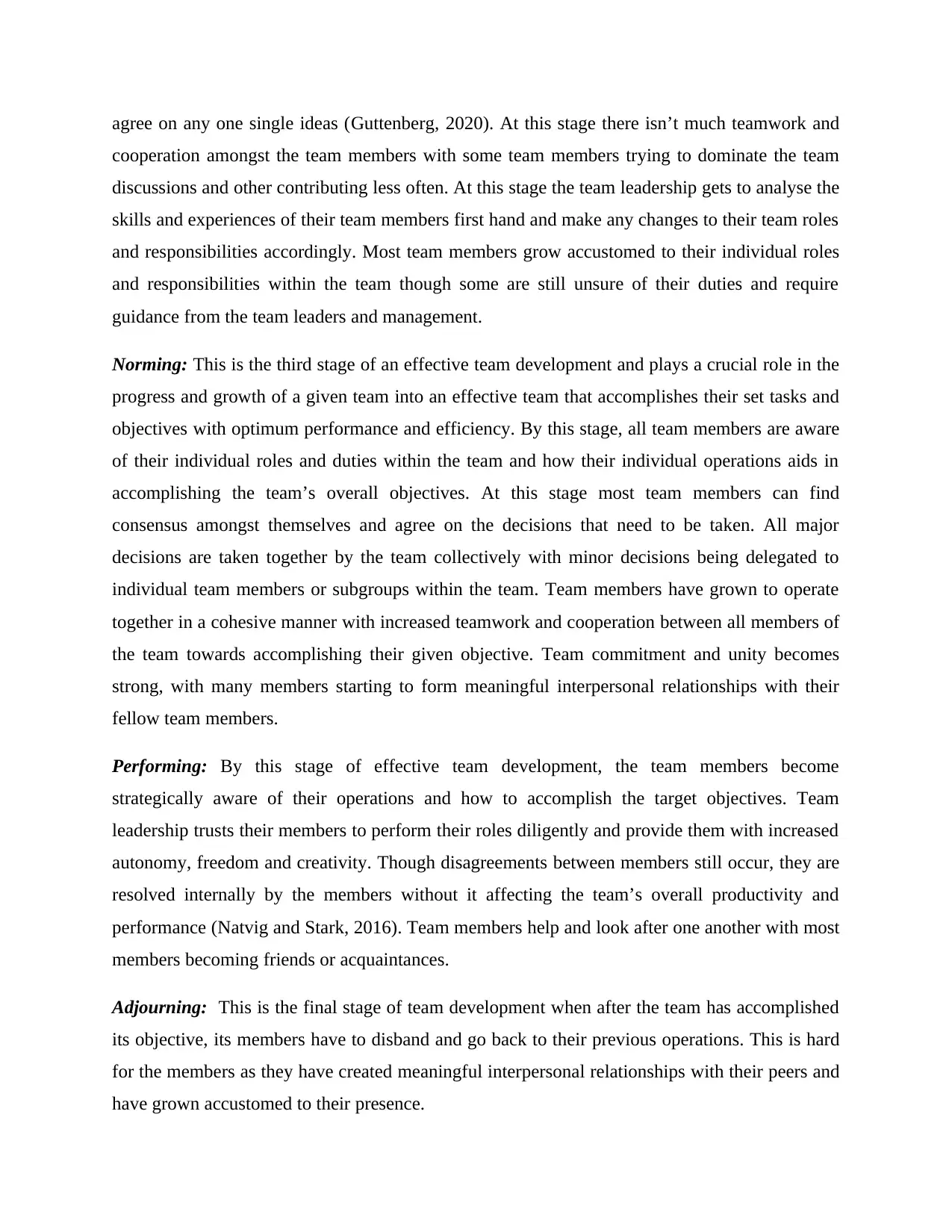
agree on any one single ideas (Guttenberg, 2020). At this stage there isn’t much teamwork and
cooperation amongst the team members with some team members trying to dominate the team
discussions and other contributing less often. At this stage the team leadership gets to analyse the
skills and experiences of their team members first hand and make any changes to their team roles
and responsibilities accordingly. Most team members grow accustomed to their individual roles
and responsibilities within the team though some are still unsure of their duties and require
guidance from the team leaders and management.
Norming: This is the third stage of an effective team development and plays a crucial role in the
progress and growth of a given team into an effective team that accomplishes their set tasks and
objectives with optimum performance and efficiency. By this stage, all team members are aware
of their individual roles and duties within the team and how their individual operations aids in
accomplishing the team’s overall objectives. At this stage most team members can find
consensus amongst themselves and agree on the decisions that need to be taken. All major
decisions are taken together by the team collectively with minor decisions being delegated to
individual team members or subgroups within the team. Team members have grown to operate
together in a cohesive manner with increased teamwork and cooperation between all members of
the team towards accomplishing their given objective. Team commitment and unity becomes
strong, with many members starting to form meaningful interpersonal relationships with their
fellow team members.
Performing: By this stage of effective team development, the team members become
strategically aware of their operations and how to accomplish the target objectives. Team
leadership trusts their members to perform their roles diligently and provide them with increased
autonomy, freedom and creativity. Though disagreements between members still occur, they are
resolved internally by the members without it affecting the team’s overall productivity and
performance (Natvig and Stark, 2016). Team members help and look after one another with most
members becoming friends or acquaintances.
Adjourning: This is the final stage of team development when after the team has accomplished
its objective, its members have to disband and go back to their previous operations. This is hard
for the members as they have created meaningful interpersonal relationships with their peers and
have grown accustomed to their presence.
cooperation amongst the team members with some team members trying to dominate the team
discussions and other contributing less often. At this stage the team leadership gets to analyse the
skills and experiences of their team members first hand and make any changes to their team roles
and responsibilities accordingly. Most team members grow accustomed to their individual roles
and responsibilities within the team though some are still unsure of their duties and require
guidance from the team leaders and management.
Norming: This is the third stage of an effective team development and plays a crucial role in the
progress and growth of a given team into an effective team that accomplishes their set tasks and
objectives with optimum performance and efficiency. By this stage, all team members are aware
of their individual roles and duties within the team and how their individual operations aids in
accomplishing the team’s overall objectives. At this stage most team members can find
consensus amongst themselves and agree on the decisions that need to be taken. All major
decisions are taken together by the team collectively with minor decisions being delegated to
individual team members or subgroups within the team. Team members have grown to operate
together in a cohesive manner with increased teamwork and cooperation between all members of
the team towards accomplishing their given objective. Team commitment and unity becomes
strong, with many members starting to form meaningful interpersonal relationships with their
fellow team members.
Performing: By this stage of effective team development, the team members become
strategically aware of their operations and how to accomplish the target objectives. Team
leadership trusts their members to perform their roles diligently and provide them with increased
autonomy, freedom and creativity. Though disagreements between members still occur, they are
resolved internally by the members without it affecting the team’s overall productivity and
performance (Natvig and Stark, 2016). Team members help and look after one another with most
members becoming friends or acquaintances.
Adjourning: This is the final stage of team development when after the team has accomplished
its objective, its members have to disband and go back to their previous operations. This is hard
for the members as they have created meaningful interpersonal relationships with their peers and
have grown accustomed to their presence.
Secure Best Marks with AI Grader
Need help grading? Try our AI Grader for instant feedback on your assignments.
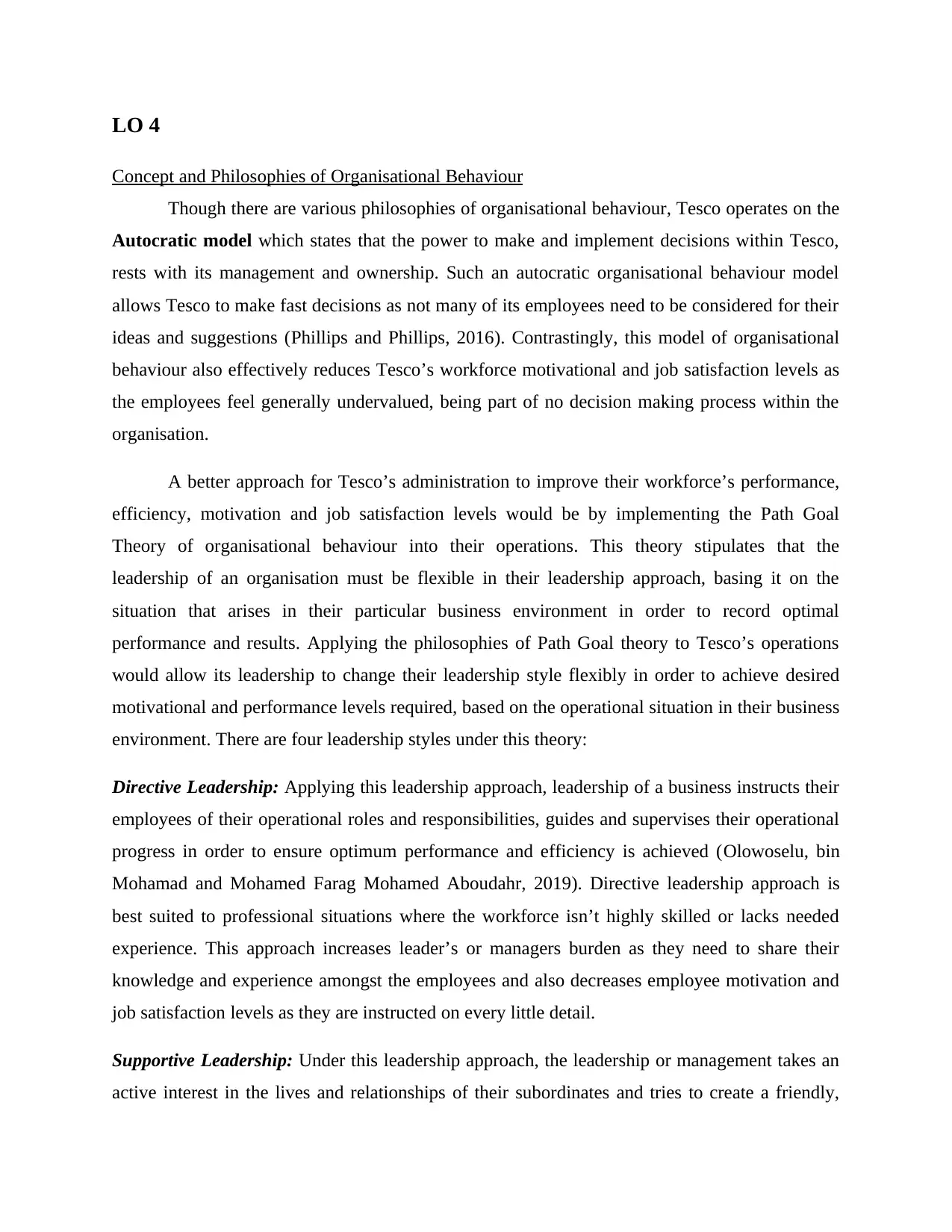
LO 4
Concept and Philosophies of Organisational Behaviour
Though there are various philosophies of organisational behaviour, Tesco operates on the
Autocratic model which states that the power to make and implement decisions within Tesco,
rests with its management and ownership. Such an autocratic organisational behaviour model
allows Tesco to make fast decisions as not many of its employees need to be considered for their
ideas and suggestions (Phillips and Phillips, 2016). Contrastingly, this model of organisational
behaviour also effectively reduces Tesco’s workforce motivational and job satisfaction levels as
the employees feel generally undervalued, being part of no decision making process within the
organisation.
A better approach for Tesco’s administration to improve their workforce’s performance,
efficiency, motivation and job satisfaction levels would be by implementing the Path Goal
Theory of organisational behaviour into their operations. This theory stipulates that the
leadership of an organisation must be flexible in their leadership approach, basing it on the
situation that arises in their particular business environment in order to record optimal
performance and results. Applying the philosophies of Path Goal theory to Tesco’s operations
would allow its leadership to change their leadership style flexibly in order to achieve desired
motivational and performance levels required, based on the operational situation in their business
environment. There are four leadership styles under this theory:
Directive Leadership: Applying this leadership approach, leadership of a business instructs their
employees of their operational roles and responsibilities, guides and supervises their operational
progress in order to ensure optimum performance and efficiency is achieved (Olowoselu, bin
Mohamad and Mohamed Farag Mohamed Aboudahr, 2019). Directive leadership approach is
best suited to professional situations where the workforce isn’t highly skilled or lacks needed
experience. This approach increases leader’s or managers burden as they need to share their
knowledge and experience amongst the employees and also decreases employee motivation and
job satisfaction levels as they are instructed on every little detail.
Supportive Leadership: Under this leadership approach, the leadership or management takes an
active interest in the lives and relationships of their subordinates and tries to create a friendly,
Concept and Philosophies of Organisational Behaviour
Though there are various philosophies of organisational behaviour, Tesco operates on the
Autocratic model which states that the power to make and implement decisions within Tesco,
rests with its management and ownership. Such an autocratic organisational behaviour model
allows Tesco to make fast decisions as not many of its employees need to be considered for their
ideas and suggestions (Phillips and Phillips, 2016). Contrastingly, this model of organisational
behaviour also effectively reduces Tesco’s workforce motivational and job satisfaction levels as
the employees feel generally undervalued, being part of no decision making process within the
organisation.
A better approach for Tesco’s administration to improve their workforce’s performance,
efficiency, motivation and job satisfaction levels would be by implementing the Path Goal
Theory of organisational behaviour into their operations. This theory stipulates that the
leadership of an organisation must be flexible in their leadership approach, basing it on the
situation that arises in their particular business environment in order to record optimal
performance and results. Applying the philosophies of Path Goal theory to Tesco’s operations
would allow its leadership to change their leadership style flexibly in order to achieve desired
motivational and performance levels required, based on the operational situation in their business
environment. There are four leadership styles under this theory:
Directive Leadership: Applying this leadership approach, leadership of a business instructs their
employees of their operational roles and responsibilities, guides and supervises their operational
progress in order to ensure optimum performance and efficiency is achieved (Olowoselu, bin
Mohamad and Mohamed Farag Mohamed Aboudahr, 2019). Directive leadership approach is
best suited to professional situations where the workforce isn’t highly skilled or lacks needed
experience. This approach increases leader’s or managers burden as they need to share their
knowledge and experience amongst the employees and also decreases employee motivation and
job satisfaction levels as they are instructed on every little detail.
Supportive Leadership: Under this leadership approach, the leadership or management takes an
active interest in the lives and relationships of their subordinates and tries to create a friendly,
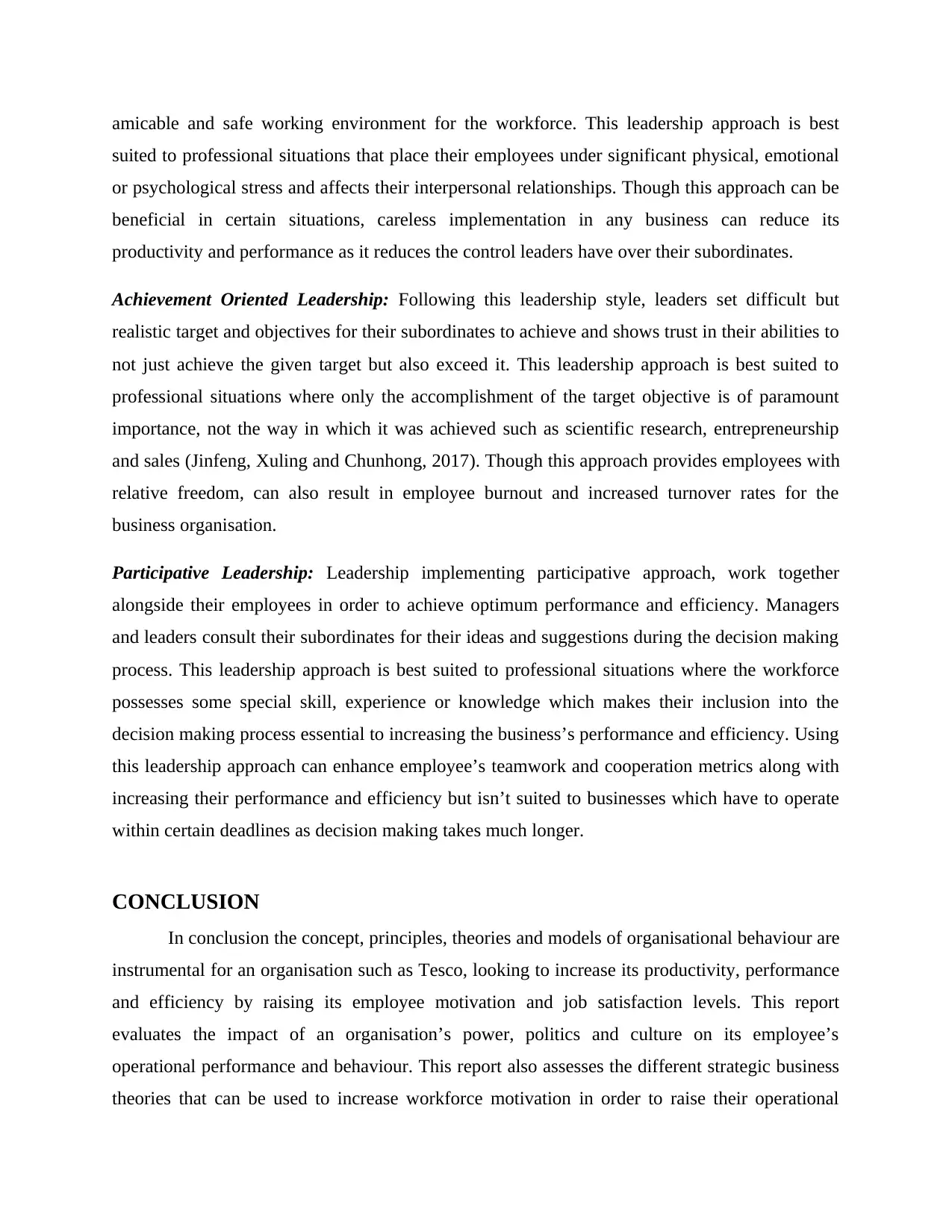
amicable and safe working environment for the workforce. This leadership approach is best
suited to professional situations that place their employees under significant physical, emotional
or psychological stress and affects their interpersonal relationships. Though this approach can be
beneficial in certain situations, careless implementation in any business can reduce its
productivity and performance as it reduces the control leaders have over their subordinates.
Achievement Oriented Leadership: Following this leadership style, leaders set difficult but
realistic target and objectives for their subordinates to achieve and shows trust in their abilities to
not just achieve the given target but also exceed it. This leadership approach is best suited to
professional situations where only the accomplishment of the target objective is of paramount
importance, not the way in which it was achieved such as scientific research, entrepreneurship
and sales (Jinfeng, Xuling and Chunhong, 2017). Though this approach provides employees with
relative freedom, can also result in employee burnout and increased turnover rates for the
business organisation.
Participative Leadership: Leadership implementing participative approach, work together
alongside their employees in order to achieve optimum performance and efficiency. Managers
and leaders consult their subordinates for their ideas and suggestions during the decision making
process. This leadership approach is best suited to professional situations where the workforce
possesses some special skill, experience or knowledge which makes their inclusion into the
decision making process essential to increasing the business’s performance and efficiency. Using
this leadership approach can enhance employee’s teamwork and cooperation metrics along with
increasing their performance and efficiency but isn’t suited to businesses which have to operate
within certain deadlines as decision making takes much longer.
CONCLUSION
In conclusion the concept, principles, theories and models of organisational behaviour are
instrumental for an organisation such as Tesco, looking to increase its productivity, performance
and efficiency by raising its employee motivation and job satisfaction levels. This report
evaluates the impact of an organisation’s power, politics and culture on its employee’s
operational performance and behaviour. This report also assesses the different strategic business
theories that can be used to increase workforce motivation in order to raise their operational
suited to professional situations that place their employees under significant physical, emotional
or psychological stress and affects their interpersonal relationships. Though this approach can be
beneficial in certain situations, careless implementation in any business can reduce its
productivity and performance as it reduces the control leaders have over their subordinates.
Achievement Oriented Leadership: Following this leadership style, leaders set difficult but
realistic target and objectives for their subordinates to achieve and shows trust in their abilities to
not just achieve the given target but also exceed it. This leadership approach is best suited to
professional situations where only the accomplishment of the target objective is of paramount
importance, not the way in which it was achieved such as scientific research, entrepreneurship
and sales (Jinfeng, Xuling and Chunhong, 2017). Though this approach provides employees with
relative freedom, can also result in employee burnout and increased turnover rates for the
business organisation.
Participative Leadership: Leadership implementing participative approach, work together
alongside their employees in order to achieve optimum performance and efficiency. Managers
and leaders consult their subordinates for their ideas and suggestions during the decision making
process. This leadership approach is best suited to professional situations where the workforce
possesses some special skill, experience or knowledge which makes their inclusion into the
decision making process essential to increasing the business’s performance and efficiency. Using
this leadership approach can enhance employee’s teamwork and cooperation metrics along with
increasing their performance and efficiency but isn’t suited to businesses which have to operate
within certain deadlines as decision making takes much longer.
CONCLUSION
In conclusion the concept, principles, theories and models of organisational behaviour are
instrumental for an organisation such as Tesco, looking to increase its productivity, performance
and efficiency by raising its employee motivation and job satisfaction levels. This report
evaluates the impact of an organisation’s power, politics and culture on its employee’s
operational performance and behaviour. This report also assesses the different strategic business
theories that can be used to increase workforce motivation in order to raise their operational
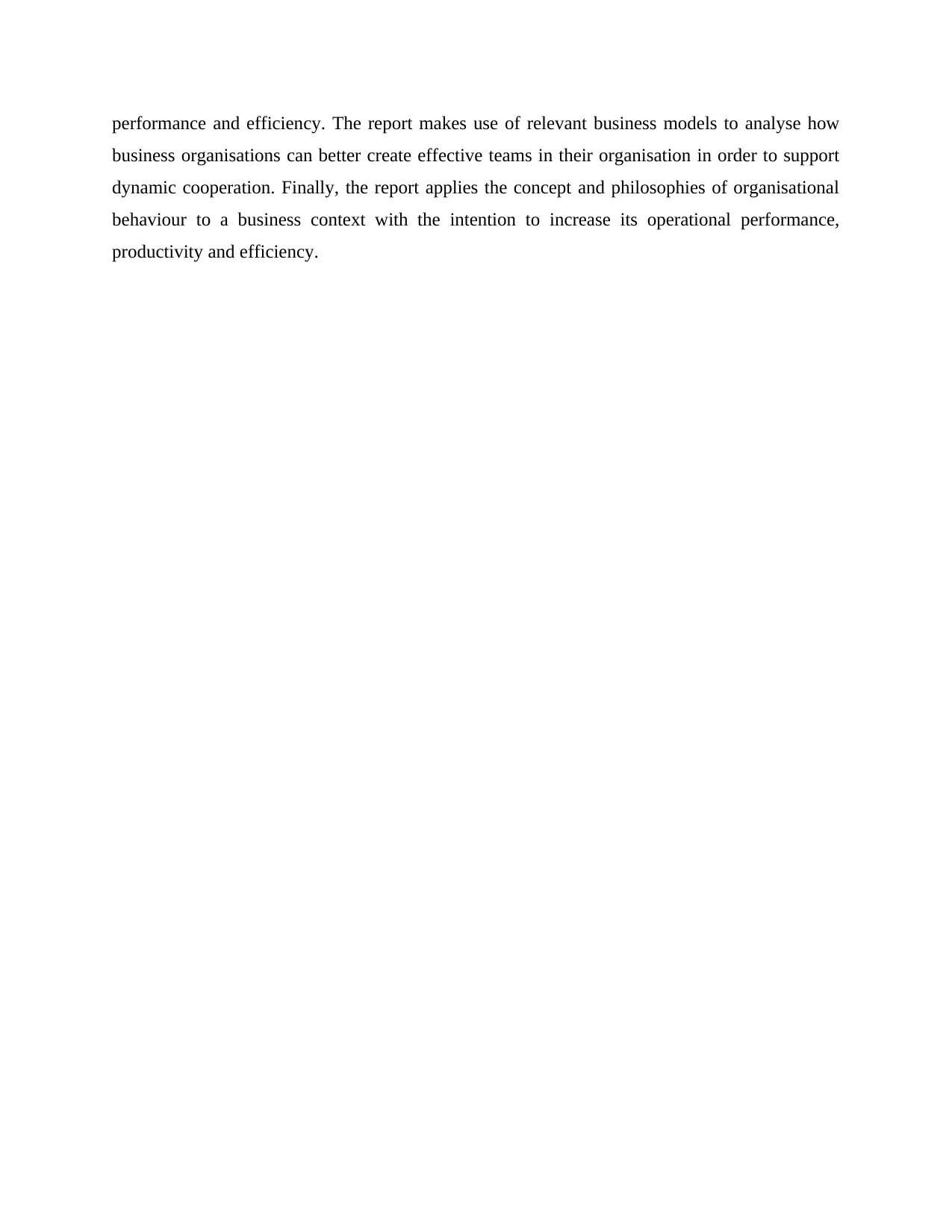
performance and efficiency. The report makes use of relevant business models to analyse how
business organisations can better create effective teams in their organisation in order to support
dynamic cooperation. Finally, the report applies the concept and philosophies of organisational
behaviour to a business context with the intention to increase its operational performance,
productivity and efficiency.
business organisations can better create effective teams in their organisation in order to support
dynamic cooperation. Finally, the report applies the concept and philosophies of organisational
behaviour to a business context with the intention to increase its operational performance,
productivity and efficiency.
Paraphrase This Document
Need a fresh take? Get an instant paraphrase of this document with our AI Paraphraser
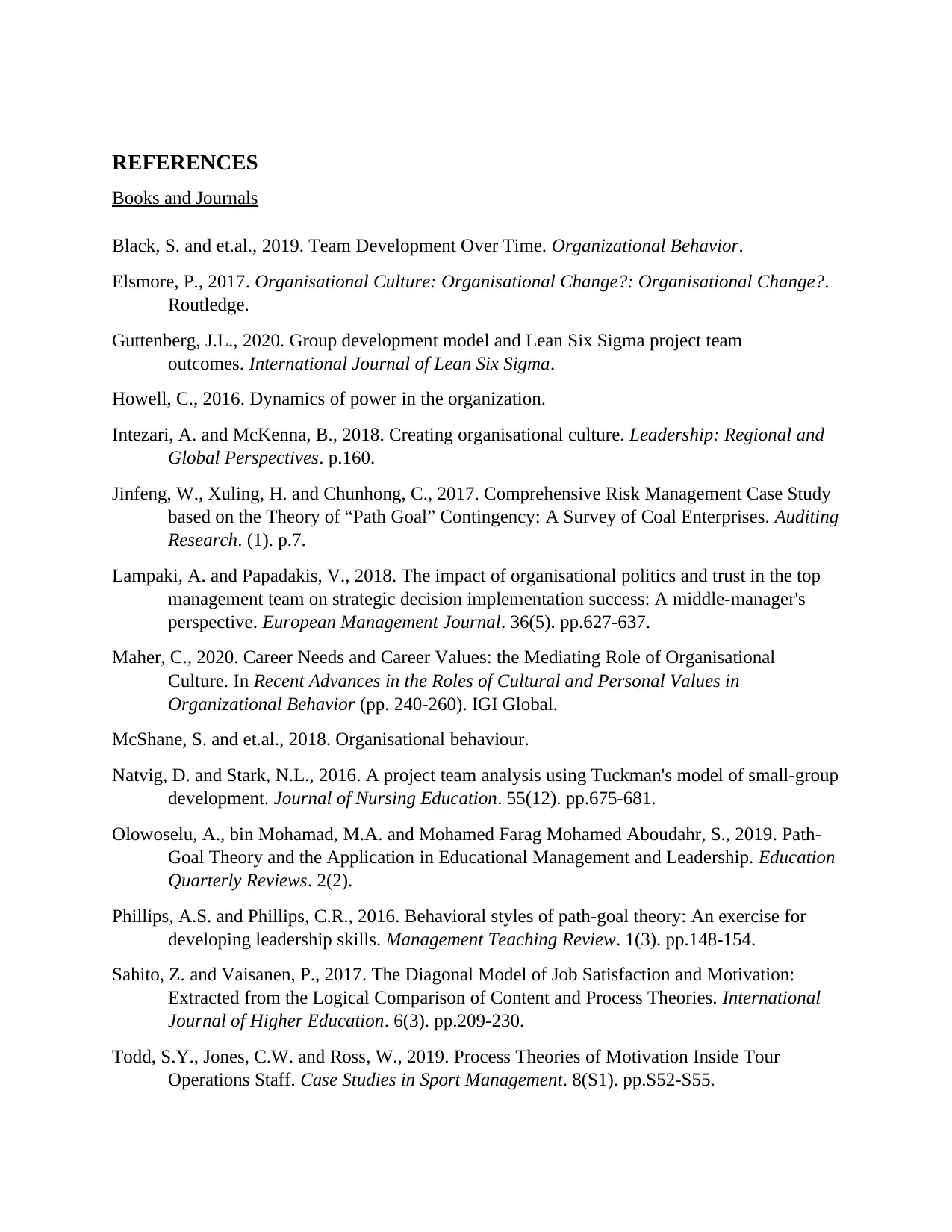
REFERENCES
Books and Journals
Black, S. and et.al., 2019. Team Development Over Time. Organizational Behavior.
Elsmore, P., 2017. Organisational Culture: Organisational Change?: Organisational Change?.
Routledge.
Guttenberg, J.L., 2020. Group development model and Lean Six Sigma project team
outcomes. International Journal of Lean Six Sigma.
Howell, C., 2016. Dynamics of power in the organization.
Intezari, A. and McKenna, B., 2018. Creating organisational culture. Leadership: Regional and
Global Perspectives. p.160.
Jinfeng, W., Xuling, H. and Chunhong, C., 2017. Comprehensive Risk Management Case Study
based on the Theory of “Path Goal” Contingency: A Survey of Coal Enterprises. Auditing
Research. (1). p.7.
Lampaki, A. and Papadakis, V., 2018. The impact of organisational politics and trust in the top
management team on strategic decision implementation success: A middle-manager's
perspective. European Management Journal. 36(5). pp.627-637.
Maher, C., 2020. Career Needs and Career Values: the Mediating Role of Organisational
Culture. In Recent Advances in the Roles of Cultural and Personal Values in
Organizational Behavior (pp. 240-260). IGI Global.
McShane, S. and et.al., 2018. Organisational behaviour.
Natvig, D. and Stark, N.L., 2016. A project team analysis using Tuckman's model of small-group
development. Journal of Nursing Education. 55(12). pp.675-681.
Olowoselu, A., bin Mohamad, M.A. and Mohamed Farag Mohamed Aboudahr, S., 2019. Path-
Goal Theory and the Application in Educational Management and Leadership. Education
Quarterly Reviews. 2(2).
Phillips, A.S. and Phillips, C.R., 2016. Behavioral styles of path-goal theory: An exercise for
developing leadership skills. Management Teaching Review. 1(3). pp.148-154.
Sahito, Z. and Vaisanen, P., 2017. The Diagonal Model of Job Satisfaction and Motivation:
Extracted from the Logical Comparison of Content and Process Theories. International
Journal of Higher Education. 6(3). pp.209-230.
Todd, S.Y., Jones, C.W. and Ross, W., 2019. Process Theories of Motivation Inside Tour
Operations Staff. Case Studies in Sport Management. 8(S1). pp.S52-S55.
Books and Journals
Black, S. and et.al., 2019. Team Development Over Time. Organizational Behavior.
Elsmore, P., 2017. Organisational Culture: Organisational Change?: Organisational Change?.
Routledge.
Guttenberg, J.L., 2020. Group development model and Lean Six Sigma project team
outcomes. International Journal of Lean Six Sigma.
Howell, C., 2016. Dynamics of power in the organization.
Intezari, A. and McKenna, B., 2018. Creating organisational culture. Leadership: Regional and
Global Perspectives. p.160.
Jinfeng, W., Xuling, H. and Chunhong, C., 2017. Comprehensive Risk Management Case Study
based on the Theory of “Path Goal” Contingency: A Survey of Coal Enterprises. Auditing
Research. (1). p.7.
Lampaki, A. and Papadakis, V., 2018. The impact of organisational politics and trust in the top
management team on strategic decision implementation success: A middle-manager's
perspective. European Management Journal. 36(5). pp.627-637.
Maher, C., 2020. Career Needs and Career Values: the Mediating Role of Organisational
Culture. In Recent Advances in the Roles of Cultural and Personal Values in
Organizational Behavior (pp. 240-260). IGI Global.
McShane, S. and et.al., 2018. Organisational behaviour.
Natvig, D. and Stark, N.L., 2016. A project team analysis using Tuckman's model of small-group
development. Journal of Nursing Education. 55(12). pp.675-681.
Olowoselu, A., bin Mohamad, M.A. and Mohamed Farag Mohamed Aboudahr, S., 2019. Path-
Goal Theory and the Application in Educational Management and Leadership. Education
Quarterly Reviews. 2(2).
Phillips, A.S. and Phillips, C.R., 2016. Behavioral styles of path-goal theory: An exercise for
developing leadership skills. Management Teaching Review. 1(3). pp.148-154.
Sahito, Z. and Vaisanen, P., 2017. The Diagonal Model of Job Satisfaction and Motivation:
Extracted from the Logical Comparison of Content and Process Theories. International
Journal of Higher Education. 6(3). pp.209-230.
Todd, S.Y., Jones, C.W. and Ross, W., 2019. Process Theories of Motivation Inside Tour
Operations Staff. Case Studies in Sport Management. 8(S1). pp.S52-S55.
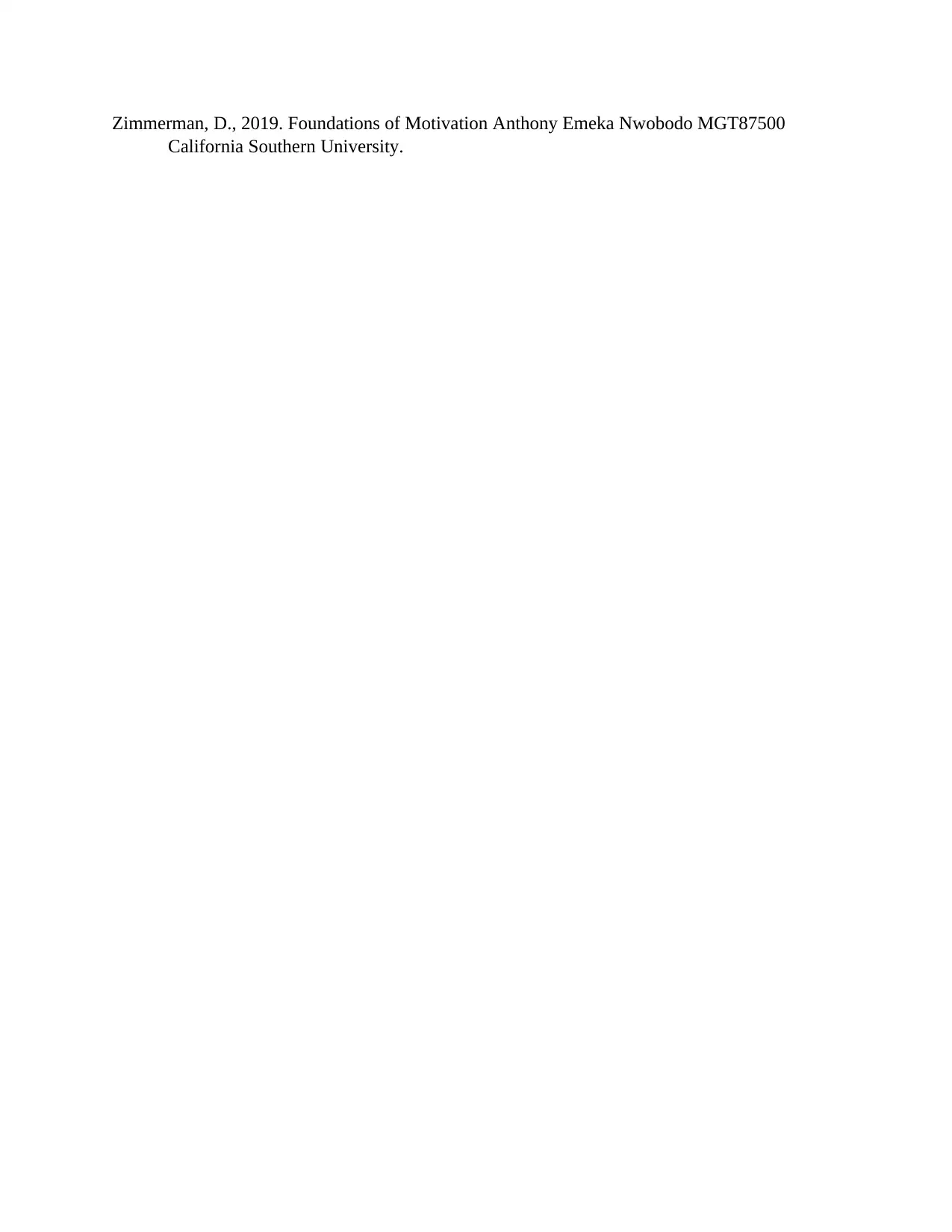
Zimmerman, D., 2019. Foundations of Motivation Anthony Emeka Nwobodo MGT87500
California Southern University.
California Southern University.
1 out of 15
Related Documents
Your All-in-One AI-Powered Toolkit for Academic Success.
+13062052269
info@desklib.com
Available 24*7 on WhatsApp / Email
![[object Object]](/_next/static/media/star-bottom.7253800d.svg)
Unlock your academic potential
© 2024 | Zucol Services PVT LTD | All rights reserved.





